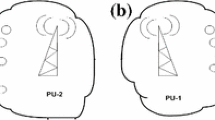Abstract
The entire operation of cognitive radio completely depends on the spectrum sensing technology in various areas. The main function of cognitive radio is to detect unused or unchecked spectrum and sharing it to other user without causing harmful interference to the primary user induced by reporting phase. Initially it requires different phases such as detection phase and reporting phase. In detection phase cognitive users detects the presence of primary users (Authenticated user). In reporting phase cognitive user forward their detection report to fusion center on existing system. In this, we proposed to analyze the effect of ROC (Receiver Operating Characteristics) with and without dedicated reporting channel in various specifications.
Access this chapter
Tax calculation will be finalised at checkout
Purchases are for personal use only
Similar content being viewed by others
References
Yadav, N., Rathi, S.: Spectrum sensing techniques: research, challenge and limitations. IJECT 2(4), (2011)
Mohapatra, S.G., Mohapatra, A.G., Lenka, S.K.: Performance evaluation of Cyclostationary based spectrum sensing in cognitive radio network. In: Automation, Computing, Communication, Control and Compressed Sensing (iMac4 s), pp. 90–97 (2013)
Kapoor, S., Singh G.: Non-cooperative spectrum sensing: a hybrid model approach. In: International Conference on Devices and Communications (ICDeCom) (2011)
Waleed, E., Najam, U.L., Seok, L., Hyung, S.K.: I3S: Intelligent spectrum sensing scheme for cognitive radio networks. In: EURASIP Journal on Wireless Communications and Networking. Springer (2013)
Rao, A.M., Karthikeyan, B.R., Mazumdar, D., Kadambi G.R.: Energy detection technique for spectrum sensing in cognitive radio. SAS_TECH J. 9(1), (2010)
Juei, C., Emad, A.: An efficient multiple lags selection method for Cyclostationary feature based spectrum-sensing. IEEE Signal Process. Lett. 20(2), (2013)
Mehta, T., Kumar, N., Saini, S.S.: Comparison of spectrum sensing techniques in cognitive radio networks. IJECT 4(3), (2013)
Author information
Authors and Affiliations
Corresponding author
Editor information
Editors and Affiliations
Rights and permissions
Copyright information
© 2019 Springer International Publishing AG, part of Springer Nature
About this paper
Cite this paper
Sambana, B., Reddy, L.S., Nayak, D.R., Rao, K.C.B. (2019). Integrative Spectrum Sensing in Cognitive Radio Using Wireless Networks. In: Rao, P., Rao, K., Kubo, S. (eds) Proceedings of International Conference on Remote Sensing for Disaster Management. Springer Series in Geomechanics and Geoengineering. Springer, Cham. https://doi.org/10.1007/978-3-319-77276-9_54
Download citation
DOI: https://doi.org/10.1007/978-3-319-77276-9_54
Published:
Publisher Name: Springer, Cham
Print ISBN: 978-3-319-77275-2
Online ISBN: 978-3-319-77276-9
eBook Packages: EngineeringEngineering (R0)




